

Ð°Ð½Ð°Ð²ÐµÑ Zheleznyj zanaves German: Eiserner Vorhang Georgian: á ááááá¡ á¤áá áá Rkinis pharda Czech and Slovak: Železná opona Hungarian: Vasfüggöny Romanian: Cortina de fier Italian: Cortina di ferro Serbian: ÐвоÐ.Various usages of the term 'iron curtain' (Russian: ÐелеРSwedish book ' Behind Russia's iron curtain' from 1923 2.3 Political, economic and military realities.Although its popularity as a Cold War symbol is attributed to its use in a speech Winston Churchill gave on the 5 March 1946 in Fulton, Missouri, Nazi German Minister of Propaganda Joseph Goebbels had already used the term in reference to the Soviet Union. It originally referred to fireproof curtains in theaters. The use of the term Iron Curtain as a metaphor for strict separation goes back at least as far as the early 19th century. Romania became the only communist state in Europe to overthrow its government with violence. The events that demolished the Iron Curtain started with peaceful opposition in Poland, and continued into Hungary, East Germany, Bulgaria, and Czechoslovakia. The nations caught behind the Iron Curtain were Poland, East Germany, Czechoslovakia, Hungary, Romania, Bulgaria, Albania and the USSR however, East Germany, Czechoslovakia and the USSR have since ceased to exist.Ĭountries that made up the USSR were Russia, Belarus, Latvia, Ukraine, Estonia, Moldova, Armenia, Azerbaijan, Georgia, Uzbekistan, Kyrgyzstan, Tajikistan, Lithuania, Turkmenistan, and Kazakhstan. Separate international economic and military alliances were developed on each side of the Iron Curtain. On the east side of the Iron Curtain were the countries that were connected to or influenced by the Soviet Union, while on the west side were the countries that were allied to the United States or nominally neutral. The term symbolizes the efforts by the Soviet Union (USSR) to block itself and its satellite states from open contact with the West and its allied states. The Iron Curtain was the name for the non-physical boundary dividing Europe into two separate areas from the end of World War II in 1945 until the end of the Cold War in 1991.

Communist Albania broke off contacts with the Soviet Union in the early 1960s, aligning itself with the People's Republic of China after the Sino-Soviet split it appears stripe-hatched with grey. Yugoslavia, member country of the Non-Aligned Movement.


 0 kommentar(er)
0 kommentar(er)
